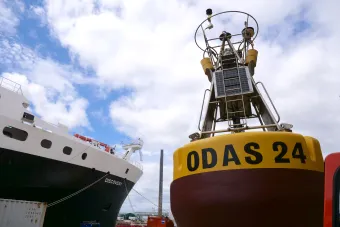
On Friday 21 June the RRS Discovery departed Southampton for this year’s annual research expedition to the Porcupine Abyssal Plain sustained ocean observatory (PAP-SO) in the northeast Atlantic.
These expeditions aim to answer questions about how environmental and ecological stressors are influencing the open ocean, by providing sustained observations throughout the depth of the ocean at the PAP-SO.
Researchers on board will be tracking the flow of the greenhouse gas carbon dioxide (CO2) from the atmosphere into the surface ocean, and the eventual fate of this carbon in the ocean depths.
Dr Susan Hartman, from the National Oceanography Centre (NOC), is leading the expedition and said “We have a long time-series of measurements from the surface to the seafloor at the PAP site and this gives us a better understanding of carbon cycling throughout the water column.
With autonomous year round measurements we can see daily and seasonal variations, as well as the multi-year time-series that help us identify trends. In fact this year marks the 30th anniversary of data from the PAP sediment traps.”
Measuring the movement of carbon from the surface ocean to the seabed requires a range of scientific instruments taking measurements at different depths within the ocean. This year the team will be collecting the first year-round atmospheric CO2 measurements at the PAP-SO, using a Met Office weather buoy. There will also be specialized sediment traps attached to a mooring wire to collect sinking, carbon-rich particles, at three different depths.
These sediment traps and samplers will also be used to measure microplastics in the water column and in seafloor sediments. Alongside the NOC’s unique long-term record of samples, these will provide information on the now common occurrence of plastics far from the coast.
The team will also be using the remotely operated vehicle HyBIS to investigate what is driving changes to communities of marine life at 4,850 metres depth (about three miles) by taking thousands of seafloor photographs. HyBIS will also be looking for plastic and other litter on the seafloor.
A principal investigator of benthic biology on this expedition, Dr Brian Bett from the NOC, said “we can see the impact of the seasons right down to the seafloor, at over three miles depth”.
Brian is an author on new research on the importance of multi-depth sustained ocean observations, published for the OceansObs 2019 conference, and in conjunction with the UN ‘Decade of the Ocean’.
Expeditions to the PAP-SO form part of the CLASS National Capability research programme, which will deliver the knowledge and understanding of the Atlantic Ocean system that policy-makers need to make evidence-based decisions regarding ocean management. This year the expedition will also be part of the new iAtlantic project that aims to deliver knowledge critical for responsible and sustainable management of Atlantic Ocean resources.
Keep updated on this expedition by reading the blog, or following the PAP observatory on Twitter and Instagram.